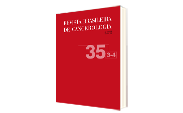Observações sobre o Desenvolvimento de Fibrossarcoma Transplantado em Gerbil (Meriones Unguiculatus)
DOI:
https://doi.org/10.32635/2176-9745.RBC.1989v35n3/4.4279Keywords:
Transplantation, Fibrosarcoma, GerbilAbstract
The authors report the study of a chemically induced and transplantable fibrosarcoma in the gerbil. This tumor was mantained by successive intraperitoneal passages using tumor cell suspension in association or not with mineral oil. The incidence, latencyperiod, growth pattern and host response were determined after subcutaneous implantation of 1 x 10F tumor cells. The latency period was significantly lower in animal receiving cell suspension derived from donors treated with mineral oil. Nevertheless incidence and overall tumor growth was similar in both groups. The kinetic analysis of tumor growth, showed an initial exponencial proliferative phase, with a tendency to convex upwards. This was also demonstreated by an increasing duplication time of the tumor area. Gerbils bearing subeutaneous fibrosarcoma lost body weight during the experimental period. Tumor weight showed a significative linear relationship with tumor area, and at least for this tumor, an estimation of tumor weight might be obtained from externai measurements of the area.
Downloads
References
Guzmán-Silva MA, Rossi MID, Guimarães JSP. Observações preliminares sobre a patologia espontânea do gerbil (Meriones unguiculatus). Arq. Flum. Med. Vet. (no prelo)
Meckley PE, Zwicker GM. Naturally occuring neoplasms in the Mongolian gerbil (Meriones unguiculatus). Lab. Anim, 1979; 13: 203-206. DOI: https://doi.org/10.1258/002367779780937915
Handler AH, Magalini SI, Pav D.Oncogenicstudies on the Mongolian gerbil. Câncer Res., 1966; 26: 844-847.
Rossi MID, Guzmán-Silva MA, Guimarães JSP. Estudo do gerbil (Meriones unguiculatus) como modelo em oncologia experimental. II. Indução de neoplasias subcutâneas. Rev. Bras. Cancerol., 1986; 32(2): 156.
Guzmán-Silva MA, Guimarães JSP. Análise morfológica comparativa de carcinogênese química cutânea entre camundongos e gerbils. Rev. Bras. Cancerol., 1986; 32(1): 31-42.
Gleiser CA, Pointer JM, Jardine JH, Raulston GL.Transplantable tumor cell line derived from a spontaneous fibrosarcoma in a gerbisl. JNCI, 1979; 62(6): 1579-1583.
Rossi MID, Guzmán-Silva MA, Guimarães JSP. Estudo do gerbil (Meriones unguiculatus) como modelo em oncologia experimental. III. Transplante homólogo de neoplasias quimicamente induzidas. Rev. Bras. Cancerol., 1986; 32(2): 156.
Steel GG, Adams K, Barret JC. Analysis of the cell population kinetics of transplanted tumors of widely-differing growth rate. Br. J. Cancer, 1966; 20: 784-800. DOI: https://doi.org/10.1038/bjc.1966.90
Steel GG, Lamerton LE. The growth rate of humans tumors. Br. J. Cancer, 1966; 20: 74. DOI: https://doi.org/10.1038/bjc.1966.9
Campos H. Estatística Experimental não paramétrica. 4ª ed. Piracicaba, São Paulo, ESA. "Luiz de Queiroz”, USP, 1983.
Vieira S. Metodologia Cientifica para a Área de Saúde. Sarvier, 1984.
Billingham RE, Silvers WK. Skin transplants and the hamster. Scientific american, 1963; 208: 118-127. DOI: https://doi.org/10.1038/scientificamerican0163-118
Karavodin LM, ASH LR. Weak graft-versus-host response in the Mongolian gerbil (Meriones unguiculatus). Lab. Anim. Sei., 1977; 27(6): 1035-1036.
StiffeI C, Mouton D, Biozzi G. Kinetics of the Phagocytíc Function of the Reticuloendothelial Macrophages in vivo. In: Vanfurth, R. ed. Mononuclear Phagocytes, Blackwell, Oxford, 1970; pp 335.
Cooper GN, Houston B. Effects of simple lipids on the phagocytíc properties of peritoneal macrophages. II. Studies on the phagocytíc potencial of cell populations. Aust. J. Exp, Biol. Med., 1964; 42: 429-442. DOI: https://doi.org/10.1038/icb.1964.40
Steel GG.Cytokineticsof neoplasias. In: Cancer Medicine Holiand, JE & Frei III, E. eds. Lea & Febiger, Philadelphia, 2ª ed., 1982; pp 177-189.
Laia PK. Age-specific changes in the proliferation of Ehrlich ascites tumor cells grown as solid tumors. Cancer Res., 1972; 32: 628-636.
Ohnuma T. Systemic effects of cancer. In: Cancer Medicine Holiand, JF & Frei III, E. eds., Lea & Febiger, Philadelphia, 1982; 2ª ed., pp 1220.
Belizário JE, Katz M, Raw I. Caracterização dos mediadores endógenos da caquexia neoplásica. In: II Encontro Nacional de Pesquisa em Câncer. Instituto Nacional do Câncer. Rio de Janeiro, 1987. Ministério da Saúde. Campanha Nacional de Combate ao Câncer.
Viera-Matos AN, Rettori D. Evolução da caquexia produzida pelo tumor Sp4 (Adenocarcinoma de mama) nos ratos WAB/NOT. In: II Encontro Nacional de Pesquisa em Câncer. Instituto Nacional do Câncer. Rio de Janeiro, 1987. Ministério da Saúde. Campanha Nacional de Combate ao Câncer.
Maury CPJ. Tumor Necrosis Factor: an OverView. Acta. Med. Scand., 1986; 220: 387-94. DOI: https://doi.org/10.1111/j.0954-6820.1986.tb02785.x
Downloads
Published
How to Cite
Issue
Section
License
Os direitos morais e intelectuais dos artigos pertencem aos respectivos autores, que concedem à RBC o direito de publicação.

This work is licensed under a Creative Commons Attribution 4.0 International License.









